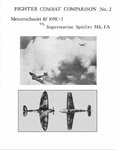HAPPY HOLIDAYS TO ALL
Well here is my Christmas present to the forum. It took me a long time to track down this document since I began looking for it in 1976.
Remember as you read it the author composed this in 1973 when some data on the Bf109E wasn't so readily available. I believe this is a good product considering the time period it was composed. Computers weren't readily accessible (I built my Heathkit H89 in 1979) and neither were good calculators and they weren't inexpensive either. (I paid $127 for my Ti-10 in 1974)
At the end of the booklet are some letters to the author about future comparisons which looked comprehensive but he only published the P40C vs A6M2 in that series and in later years started a new series with the F6F-5 v J2M3 but never completed any more.
I do of course have my observations which are;
Lack of references to support certain statements.
Stall warning comments between 109 and Spit on pg 10.
Stated engine installation in the 109 being the DB601Aa….I think there is enough data out on the web to indicate this should be a DB601A. The 601A would have given the 109 a slightly higher critical altitude but less power below the critical altitude. Pg10.
Showing the 109 have three MG/FF cannon instead of only the wing installation. Pg12.
Another criticism about evaluating weapons is that everyone looks at weight of fire and explosive effects but I don't think enough words are devoted to the number of rounds shot in a 3 second burst. The 109 shoots a total of 35 20mm and 102 7.9mm for a total of 137 projectiles in a three second burst. The Spit shoots a total of 540 projectiles in three seconds. This gives the Spitfire pilot 4 times the chance to obtain hits over the Bf109.
Another issue overlooked is in a turning deflection shot the 109 pilot won't be able to obtain hits with all his guns due to the very different ballistics between the slow 20mm MG/FF and the faster velocity 7.9 MG17 rounds.
Of course there will be those who will deride the performance numbers and conclusion offered but the author used the DB601Aa so that will taint the results somewhat. Unless of course you want to compare an export Bf109E instead of a BoB Luftwaffe Bf109E.
Well here is my Christmas present to the forum. It took me a long time to track down this document since I began looking for it in 1976.
Remember as you read it the author composed this in 1973 when some data on the Bf109E wasn't so readily available. I believe this is a good product considering the time period it was composed. Computers weren't readily accessible (I built my Heathkit H89 in 1979) and neither were good calculators and they weren't inexpensive either. (I paid $127 for my Ti-10 in 1974)
At the end of the booklet are some letters to the author about future comparisons which looked comprehensive but he only published the P40C vs A6M2 in that series and in later years started a new series with the F6F-5 v J2M3 but never completed any more.
I do of course have my observations which are;
Lack of references to support certain statements.
Stall warning comments between 109 and Spit on pg 10.
Stated engine installation in the 109 being the DB601Aa….I think there is enough data out on the web to indicate this should be a DB601A. The 601A would have given the 109 a slightly higher critical altitude but less power below the critical altitude. Pg10.
Showing the 109 have three MG/FF cannon instead of only the wing installation. Pg12.
Another criticism about evaluating weapons is that everyone looks at weight of fire and explosive effects but I don't think enough words are devoted to the number of rounds shot in a 3 second burst. The 109 shoots a total of 35 20mm and 102 7.9mm for a total of 137 projectiles in a three second burst. The Spit shoots a total of 540 projectiles in three seconds. This gives the Spitfire pilot 4 times the chance to obtain hits over the Bf109.
Another issue overlooked is in a turning deflection shot the 109 pilot won't be able to obtain hits with all his guns due to the very different ballistics between the slow 20mm MG/FF and the faster velocity 7.9 MG17 rounds.
Of course there will be those who will deride the performance numbers and conclusion offered but the author used the DB601Aa so that will taint the results somewhat. Unless of course you want to compare an export Bf109E instead of a BoB Luftwaffe Bf109E.

